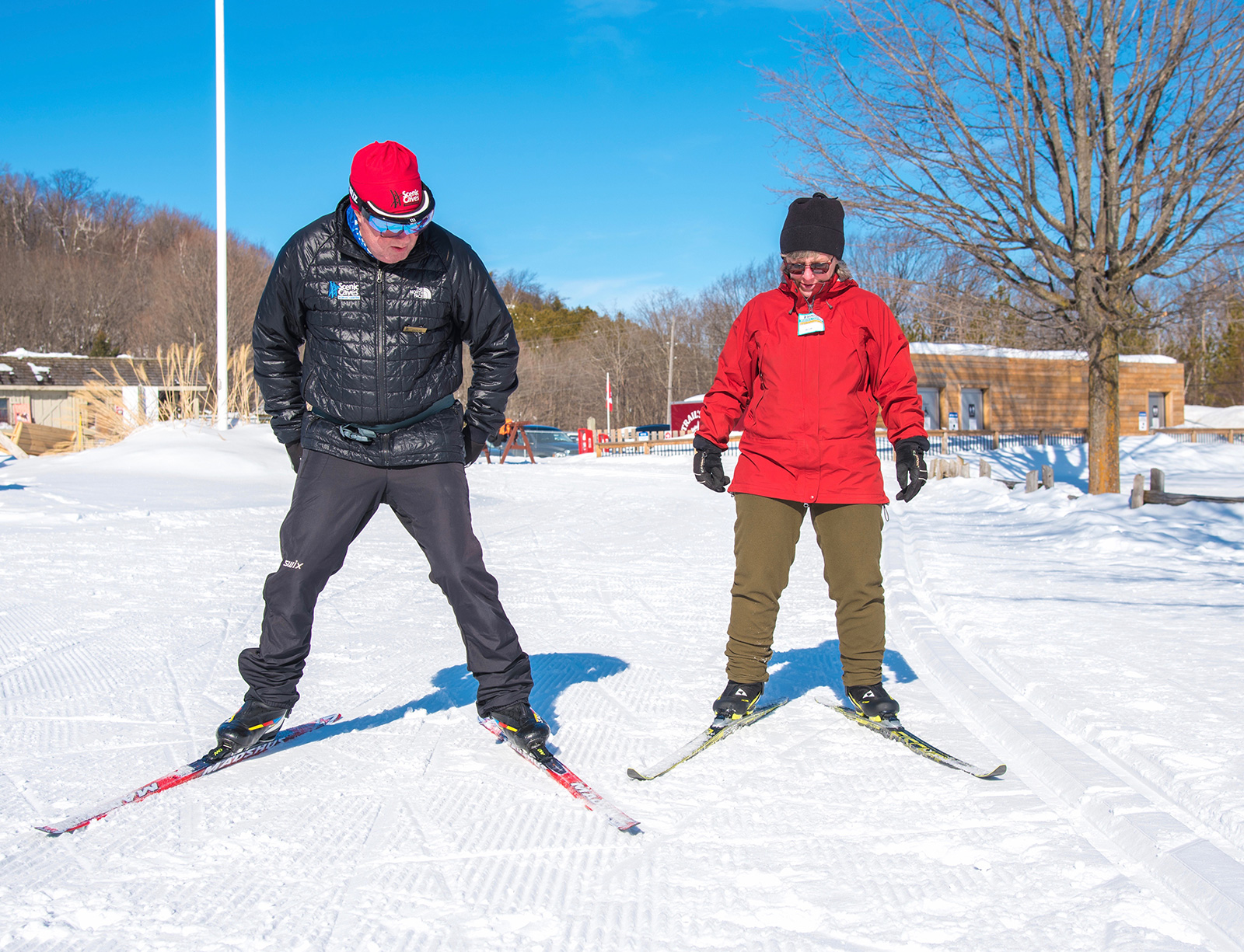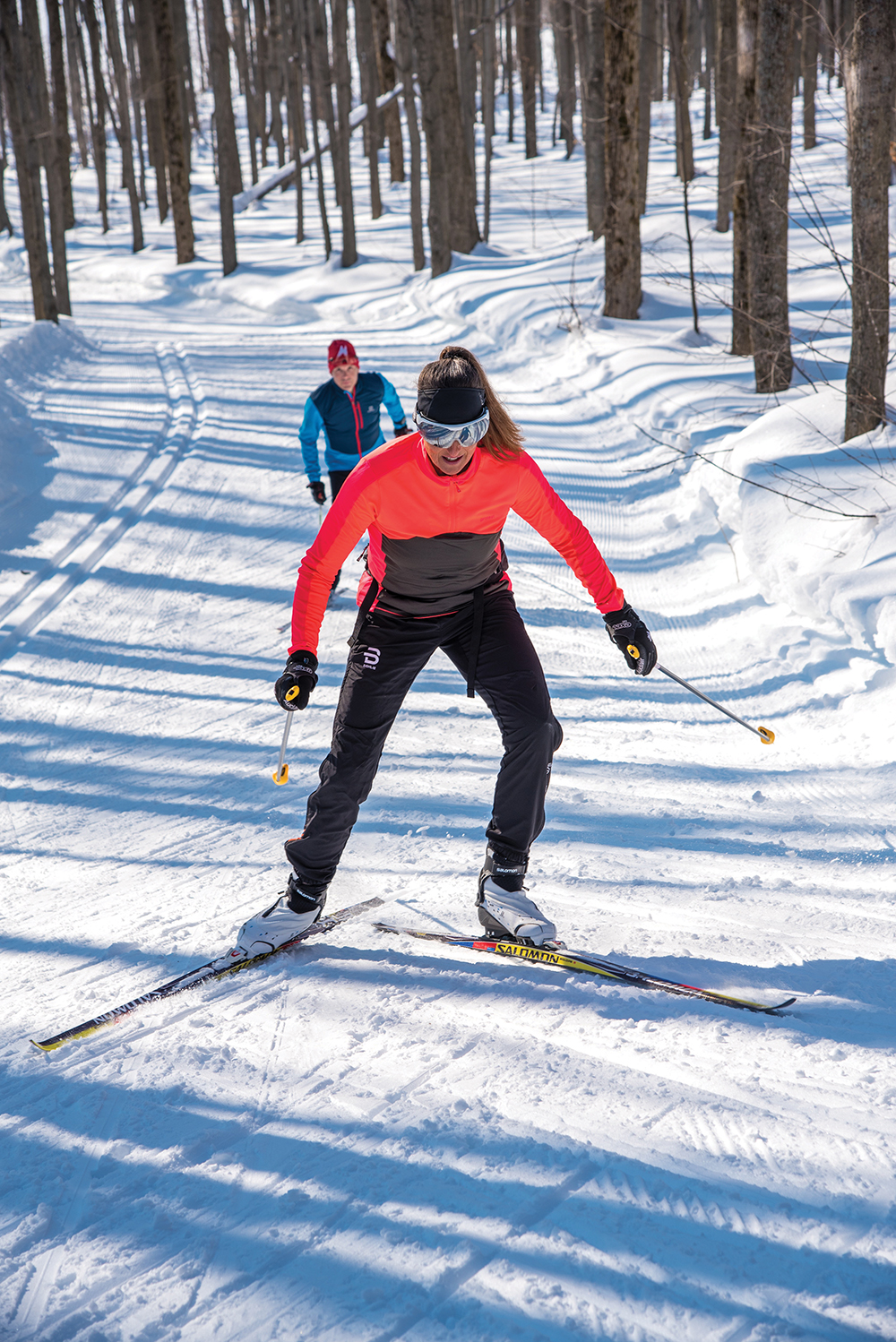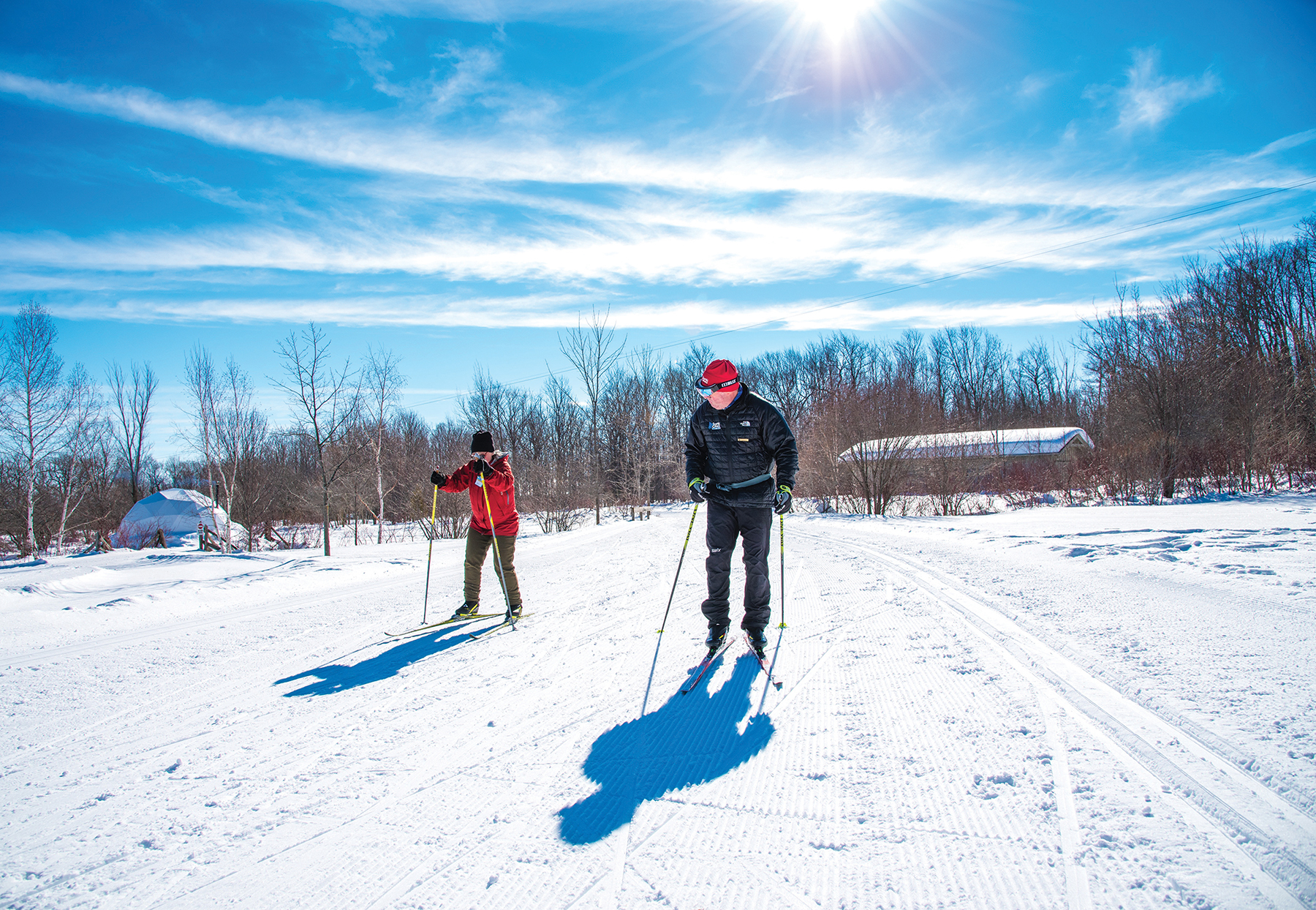

I feel a flash of exhilaration as I glide, one long stride after another, on my thin skate skis. Seven, eight, nine — I’m floating on the crisp snow. And then, just like that, my rhythm is gone and I struggle to keep from falling over.
Such is the experience of learning how to skate ski, a type of cross-country skiing that tests your fitness to its extreme limits. My instructor on this day is Doug Fox, an experienced cross-country skier who has graciously agreed to help me learn this discipline on the well-groomed trails at the Scenic Caves Nordic Centre.
Skate skiing is certainly a different beast than classic cross-country skiing where skiers use a walking motion, keeping their skis in the dual track and using one pole at a time.
Instead, picture a long-track speed skater lapping the track in long, slow strides that seem effortless. Put that speed skater on thin skis, add two long poles that are used in unison to push off the flat track, and that gives you the skate-skier technique.
Balance, above everything else, is needed for perfect skate-ski form, says Fox, a semi-retired teacher from Nottawa who teaches both cross-country disciplines at Scenic Caves and is a member at Highlands Nordic in Duntroon.



That’s something that takes some time to learn, but a perfect skate skier is just beautiful to watch because there appears to be very little wasted motion, everything is working efficiently together. They’re going like hell, but it seems effortless because they’re letting physics do so much of the work for them.

Skate skiing, more properly called “freestyle” cross-county skiing, first gained international recognition in the 1980s. American skier Billy Koch had heard about older Norwegians using the freestyle technique and went to train with them. He then used the technique in international cross-country competitions, and in 1982, was crowned overall World Cup champion.
By 1985, athletes were widely using the technique in international competitions, and it was formally adopted as a competitive sport by the International Ski Federation in 1986.
Since then, skate skiing has risen steadily in popularity at the recreational level. And the two venues close to Collingwood —Scenic Caves and Highlands Nordic — add spectacular scenery to the mix.
Scenic Caves is set atop the Niagara Escarpment — one of Canada’s UNESCO biosphere reserves — and its 27 kilometres of cross-country ski trails wind through an old growth forest.
“The dedicated trail systems for both skiing and snowshoeing have well-marked trails, offering gentle rolling slopes to steep climbs, and expansive views,” says Linda Service, vice president of marketing and business development for Scenic Caves Nature Adventures. “The trails are professionally groomed and the track is set daily for both classic and skate skiing.”
Highlands Nordic boasts 30 kilometres of groomed trails for skate and classic skiers, including a flat, three-kilometre dog-friendly trail called Teal’s Tango that is named for co-owner Kelly Sinclair’s dog, Teal. About 80 per cent of the trails at Highlands Nordic are sheltered in the trees, with some offering stunning views of Georgian Bay.
“I always say that Scenic Caves sort of cheated a little bit, because they are already on top of the Escarpment,” jokes Sinclair. “We get the pleasure of going up and down the Escarpment. So, I would describe our trails as a little bit more challenging than the Scenic Caves network.”
Both venues have seen a steady growth in both cross-country skiing and snowshoeing in recent years as people seem increasingly interested in getting outdoors for exercise and adventure. Both typically see a mix of skate and classic skiers — although still more of the classic type — of varying levels of proficiency.
Highlands Nordic tends to attract more high-performance style skiers because it has a history of hosting races, but still welcomes skiers of all levels, says Sinclair.
And many skiers do both disciplines. Linda Service says she is seeing more interest from classic skiers wanting to learn the techniques of skate skiing, and they will often rent skate-skiing equipment and take a lesson first before making the investment in additional equipment.
At each venue, the setting is therapeutic — trails winding through wooded areas that open into fields with stunning vistas. It’s the perfect mental health tonic for those feeling isolated during the seemingly never-ending pandemic.
“The benefits of nature and outdoor therapy are becoming more widely understood as significant to our mental health,” says Service. “There is a new degree of interest in getting outdoors, to escape into a serene, natural environment that allows for safe socializing.”
Both locations are maintaining government-required pandemic protocols. This involves staff and guest screening for COVID-19 symptoms, two-metre distancing in high traffic areas, and mandatory masks inside and outside of ticket/registration buildings.
Guests must purchase tickets or rentals via touch-free payment. No cash transactions are allowed.
“Of course, we keep on top of the current COVID situation and will be prepared to react with any changes based on government and public health advice or orders,” says Service.
In addition to the mental health benefits of outdoor activity, another reason for skate skiing’s rising popularly is its reputation as a lung-busting, full-body workout. In fact, the athlete with the highest VO2 max (lung capacity) ever recorded was Norwegian Nordic skier Bjørn Dæhlie.
“Skate skiing is huge with the cardio junkies, like bikers and runners,” says Sinclair. “They love it because they can go out and they can ski their buns off for an hour and get an awesome workout and then be done. If you’re doing it right, you’re working your arms, your core, and your legs.”
I can attest to that. It’s a mild winter day under a spectacular sun and I am soon quite sweaty as Fox puts me through my lesson. My first issue is adjusting to the skis. As a downhill skier, I appreciate wide, metal-edged skis that help me maintain my balance. By contrast, freestyle skis are longer, very thin and have no metal edges. They also have a natural bend to them that flattens out when your body is properly positioned over the “sweet spot” of the ski. Due to all of these differences, I find it harder to maintain my stability on the snow and I have to work my thighs more in snowplowing to a stop.
The poling technique is very new to me, too. Instead of using one pole at a time, I must plant both of them out in front of me at the same time. And, they’re really long — up to my nose. I have to concentrate very hard to use the poles correctly and effectively.
After I get a little more comfortable, Fox takes me into the woods to do more work on the fundamentals: the skate glide on the flats, the snowplow, and the “herringbone” stride for climbing a hill.
The herringbone requires me to angle the tips of my skis into a V and press the inside edge of each ski into the snow while using my poles to push off. It takes every ounce of strength in my legs and arms as I muscle up a tiny incline.
It’s all very humbling, and Fox reminds me a few times to “let the skis do the work.” And then, towards the end of my lesson, I have that eureka moment when it all comes together for a brief spell. I find that sweet spot for my balance, and I complete long, slow glides for several strides. I feel a deep sense of satisfaction, and that’s enough for me to consider this outing a success.
As we head back along the flats to the hut, I realize I am fully exhausted, almost every leg and arm muscle in a state of complaint. Fox tells me that is no surprise.
“Like a lot of self-taught skate skiers, I was a road biker, runner, mountain biker, and I figured I could compensate for my lack of technique by just trying harder,” he says. “Unfortunately, since it’s such a technique-driven sport, that has the opposite effect and you wind up getting more tired and going slower.”
Once he got down the glide and herringbone technique — hill climbing is critical in this area — he found he could ski faster and farther. “And, I got far more enjoyment out of the sport because I wasn’t ready to collapse by the time I was done,” he says.
I reflect on his comments as I gingerly climb into my car and sit for a moment before heading home. A feeling comes over me, one I used to experience as a runner many years ago — a deep and relaxing state of euphoria that comes after an intense session of exercise.
I’ve missed that “runner’s high,” and now I know exactly how to bring it back.














